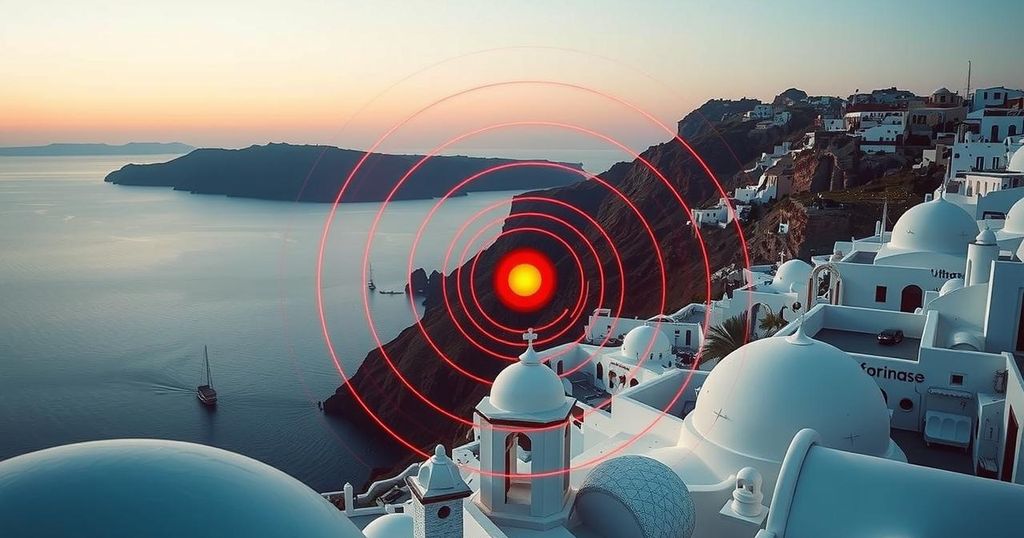Intensifying Seismic Activity in Santorini Raises Concerns of Greater Quakes

The seismic activity near Santorini has intensified since February, with over 7,700 earthquakes recorded, instigating widespread concern among residents and experts. Key figures emphasize the need for vigilance, suggesting the region remains susceptible to significant seismic events, while geologists conduct further studies to understand the situation better. Reports of possible tsunami threats have arisen in nearby areas, including Israel, prompting emergency preparedness measures.
Seismic activity around the Greek island of Santorini has notably escalated since February 9, with a significant earthquake registering a magnitude of 5.0 off the coast. This event, occurring 15 kilometers southwest of Arkessini on Amorgos, was the most powerful quake since one of 5.2 that took place on February 5, raising alarms about the risk of an even larger seismic event.
Vasilis Karastathis, the Director of the Geodynamic Institute, expressed cautious optimism regarding this recent seismic pattern, noting, “Since the day before yesterday, a better rhythm has started, a slower rhythm in the earthquakes. This has been maintained.” He affirmed, however, that the possibility of a stronger earthquake remains.
The increase in tremors has caused considerable anxiety among residents of Santorini and nearby islands, prompting many to prepare for emergencies by keeping bags in their vehicles overnight. Reports indicate that thousands of inhabitants and tourists have evacuated the island in recent weeks due to ongoing seismic disturbances.
Professor Panagiotis Karydis emphasized the relevance of the earthquake’s epicenter in predicting the level of potential damage: “An earthquake from the northeastern side of Santorini, at 6 Richter, in my opinion, will create much smaller problems than one at 4.5-5 Richter from the area of the Caldera.” He pointed out that seismic events from different locations can have varying consequences.
Experts continue to monitor the seismic situation closely, installing additional seismographs to enhance data collection. Oceanographic studies are also set to examine the causes behind the persistent tremors observed in the region. Since January 26, there have been approximately 7,700 recorded earthquakes in the Santorini-Amorgos zone, with nearly 6,000 tremors detected in the maritime area.
Seismologist Gerasimos Papadopoulos remarked on the seismic sequence, stating, “We have reached the critical point. We have the first case, if the 5.2 Richter was the main one.” Further assessment is essential to ascertain whether the seismic activity is diminishing.
Concerns about a potential tsunami stirred fear beyond Greece’s borders, especially in Israel. An emergency meeting of the National Security Council was convened to analyze the situation, with government agencies collaboratively evaluating the potential threat.
Dr. Efraim Laor assessed the risk by indicating that the likelihood of a tsunami wave affecting Israel from Greece is minimal. He noted, “In any case, if an earthquake of more than 6.5 degrees occurs on the island, then there will definitely be a tsunami, but it is not at all certain that it will reach Israel.”
The geological features of this area are considerably complex, as the region between Santorini and Amorgos is recognized for its seismic activity, characterized by several large faults indicative of tectonic movements. Historical precedents intensify these concerns, recalling a destructive 7.7 magnitude earthquake in 1956 that resulted in significant damage across Santorini, Crete, and other Eastern Mediterranean locales, as well as a 30-meter-high tsunami.
The recent surge of seismic activity around Santorini, marked by over 7,700 earthquakes since January, has prompted serious concerns among residents and experts alike. Detailed assessments are ongoing to analyze the potential risks associated with larger seismic events, as well as the potential implications for neighboring areas including Israel. The geological intricacies of the region further heighten the urgency of monitoring and preparedness efforts.
Original Source: www.jpost.com








